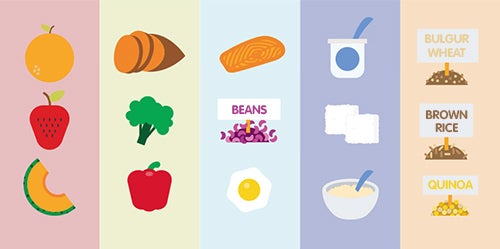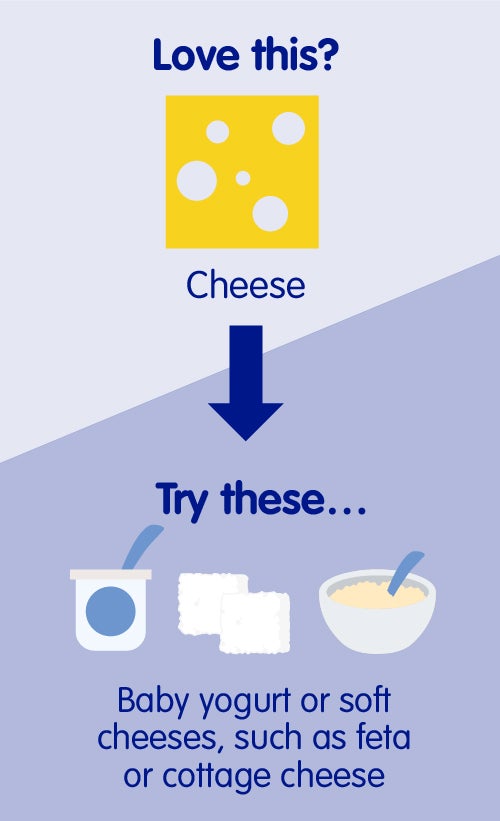
Mix up the menu!

Five food groups
Variety, balance, and multiple tries are keys to a healthy diet for your baby. Offer him foods from each of the five groups every day, and be sure he’s getting the chance to experience different textures.

1. FRUITS

Sweet-tasting and easy to mash even with few, or no, teeth, bananas are the unsurprising worldwide winner when it comes to babies’ favorite fruit. A great nutritional choice, they are full of potassium, which helps your baby’s muscles and nerve cells work properly.
Mix it up: Give your baby some more variety by swapping bananas for cantaloupe melon, strawberries or oranges—all potassium-packed health heroes.
2. VEGETABLES

Carrots are a firm favorite for tiny tummies and recently topped the charts as a number-one vegetable consumed by babies aged 6-12 months. You can offer your baby cooked carrots in various ways, from mashed to bite-sized pieces. They are rich in beta-carotene, an antioxidant that your baby’s body converts into vitamin A. This vitamin is essential for your little one’s healthy eyesight.
Mix it up: Serve sweet potatoes, red peppers, or broccoli instead of carrots at mealtimes and you’ll still be giving your baby a source of essential vitamin A.
3. MEAT/FISH/PROTEIN FOODS

Poultry, such as chicken or turkey, is a popular food for many beginner eaters, and the rest of the family too. Easy to cook, it can be prepared in lots of different ways and served as part of a variety of meals. Poultry is a good source of protein, which helps your baby’s body grow, as well as keeping his bones, muscles, blood, skin, hair, and organs healthy.
Mix it up: Next time you’re at the store, put salmon, beans, or eggs in your shopping cart instead of chicken. Beans and eggs are great non-meat sources of protein, while protein-rich salmon has the added benefit of containing DHA, which helps your little one’s brain develop.
4. GRAINS

Soft to eat and easy for little fingers to grasp, pasta is a much-loved food for many babies. It’s quick to cook and can be enjoyed hot or cold, with or without sauces. Pasta is also high in B vitamins and fiber (if you choose wholewheat varieties). B vitamins turn your baby’s food into energy and fiber helps your baby’s digestion.
Mix it up: Before automatically putting pasta into your pan, consider whole grains, such as bulgur wheat, quinoa, or brown rice for a bit of variety. Your baby may enjoy these slightly different textures, and he’ll still be getting essential B vitamins and fiber in his diet.
5. DAIRY

Diced for little fingers, cheese is a staple food for many babies. It provides your little one with lots of important nutrients, including calcium, which helps build his bones and teeth.
Mix it up: Softer cheeses, such as feta or cottage cheese, are great alternatives to harder cheeses like cheddar as long as they are pasteurized. They give your baby the chance to try different textures without missing out on bone-building calcium. Baby yogurt is another good source of calcium.
Sources
Duyff, RL (2017). Academy of Nutrition and Dietetics. Complete food and nutrition guide (5th ed.). Boston, MA: Houghton Mifflin Harcourt.
|
Shelov SP & Altmann TR (Eds.). (2009). American Academy of Pediatrics. The complete and authoritative guide Caring for your baby and young child birth to age 5 (5th ed.). USA: Bantam Books. |


















